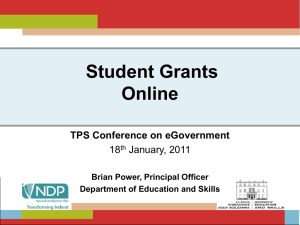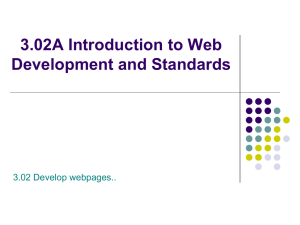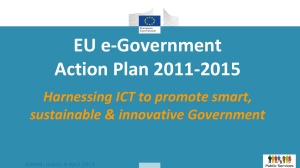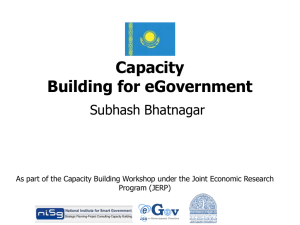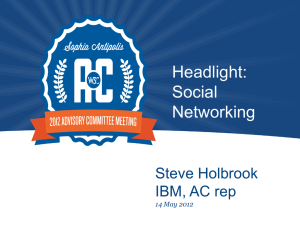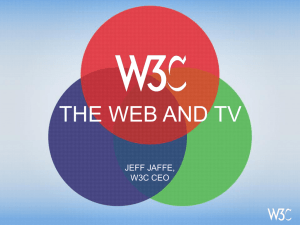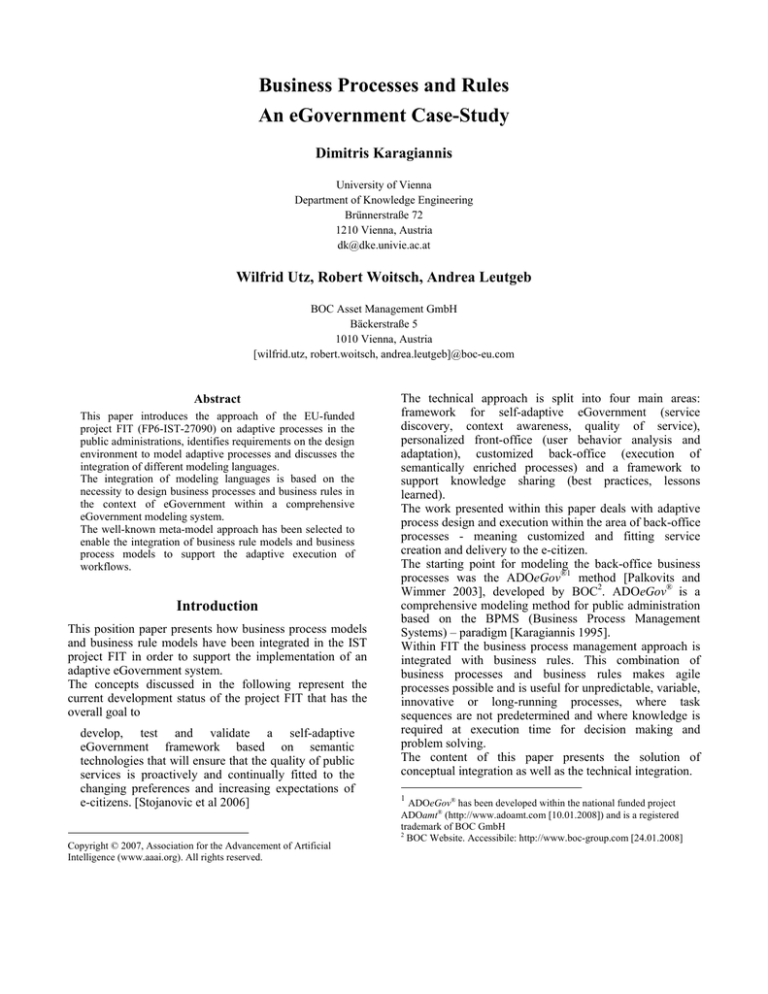
Business Processes and Rules
An eGovernment Case-Study
Dimitris Karagiannis
University of Vienna
Department of Knowledge Engineering
Brünnerstraße 72
1210 Vienna, Austria
dk@dke.univie.ac.at
Wilfrid Utz, Robert Woitsch, Andrea Leutgeb
BOC Asset Management GmbH
Bäckerstraße 5
1010 Vienna, Austria
[wilfrid.utz, robert.woitsch, andrea.leutgeb]@boc-eu.com
Abstract
This paper introduces the approach of the EU-funded
project FIT (FP6-IST-27090) on adaptive processes in the
public administrations, identifies requirements on the design
environment to model adaptive processes and discusses the
integration of different modeling languages.
The integration of modeling languages is based on the
necessity to design business processes and business rules in
the context of eGovernment within a comprehensive
eGovernment modeling system.
The well-known meta-model approach has been selected to
enable the integration of business rule models and business
process models to support the adaptive execution of
workflows.
Introduction
This position paper presents how business process models
and business rule models have been integrated in the IST
project FIT in order to support the implementation of an
adaptive eGovernment system.
The concepts discussed in the following represent the
current development status of the project FIT that has the
overall goal to
develop, test and validate a self-adaptive
eGovernment framework based on semantic
technologies that will ensure that the quality of public
services is proactively and continually fitted to the
changing preferences and increasing expectations of
e-citizens. [Stojanovic et al 2006]
Copyright © 2007, Association for the Advancement of Artificial
Intelligence (www.aaai.org). All rights reserved.
The technical approach is split into four main areas:
framework for self-adaptive eGovernment (service
discovery, context awareness, quality of service),
personalized front-office (user behavior analysis and
adaptation), customized back-office (execution of
semantically enriched processes) and a framework to
support knowledge sharing (best practices, lessons
learned).
The work presented within this paper deals with adaptive
process design and execution within the area of back-office
processes - meaning customized and fitting service
creation and delivery to the e-citizen.
The starting point for modeling the back-office business
processes was the ADOeGov®1 method [Palkovits and
Wimmer 2003], developed by BOC2. ADOeGov® is a
comprehensive modeling method for public administration
based on the BPMS (Business Process Management
Systems) – paradigm [Karagiannis 1995].
Within FIT the business process management approach is
integrated with business rules. This combination of
business processes and business rules makes agile
processes possible and is useful for unpredictable, variable,
innovative or long-running processes, where task
sequences are not predetermined and where knowledge is
required at execution time for decision making and
problem solving.
The content of this paper presents the solution of
conceptual integration as well as the technical integration.
1
ADOeGov® has been developed within the national funded project
ADOamt® (http://www.adoamt.com [10.01.2008]) and is a registered
trademark of BOC GmbH
2
BOC Website. Accessibile: http://www.boc-group.com [24.01.2008]
Business Processes and Business Rules
Integration
The approach, which has been developed by the FIT
project partners BOC and FHNW1, addresses the challenge
that processes in eGovernment are often quite complex and
therefore quite difficult to change. Here the business rules
approach can provide a powerful improvement by making
business rules that are implicit in the process explicit. One
benefit of this separation is that there often are separate
reasons for updates to processes or business rules. New
regulations or business strategies may affect the business
rules without the necessity of changing the business
processes.
The ability of business rules to support dynamic changes,
allows modifying a business process implementation
without changing and redeploying it. On the other hand
new applications or procedures might change the business
process. Such arguments led to a composite approach to
business rules and processes, as also mentioned in
[Lienhard and Künzi 2005] or [Schacher and Grässle
2006].
Light weighted and streamlined processes are created
applying the business rules approach. These kinds of
processes only include the necessary series of steps to
accomplish the required work/service from an end-user’s
perspective.
The FIT project uses the business rules approach for the
following application areas: Variable Process Execution to
determine activities and processes to be executed during
process runtime, Intelligent Resource Allocation at runtime
to select employees based on special skills, to present
information depending on user categories or to select a
particular Web-Service and Intelligent Branching and
Decision Making at runtime to control the process flow
accordingly.
Modeling Language Integration - Methodology
The business rules approach has grown in importance and
popularity in the last few years for agile modeling
approaches. Therefore it was implemented within FIT. The
developed approach is ontology-based and results in the
definition of transparent, flexible and efficient processes in
eGovernment.
Business Rules Management is integrated into the
ADOeGov® method providing the ability to model
business rules on different abstraction layers. Three
abstraction levels serve three different user groups, the first
level is the business/design view, the second level is the
interchange level and the third level is the
technical/execution level. Each of the three business rules
abstraction layers is integrated with the according
abstraction layer of the business processes.
1
FHNW Website. Accessible: http://www.fhnw.ch [10.01.2008]
An organizational framework and methodology supports
the designer to formalize the “verbal” rule definition on the
highly abstract level to an executable level (see
[Hinkelmann et al 2007] for details).
Figure 1 depicts the ADOeGov® modeling language and
the additional modules, as they were developed within the
project.
ADOeGov
Workflow Management
Make Executable
Provide Adaptivity
Business Rules Management
Provide Adaptivity
Ensure Formality
Ontology Management
Figure 1: Modeling Language Integration
The figure presents sample models of FIT to show how the
connection between different modeling languages is
qualified from a conceptual perspective.
The input for the semi-formal representation of business
processes and rules are document sources (e.g. laws,
regulations etc.),
existing
process
models
or
interviews/workshops with domain experts, as business
rules and processes are often stored in the mind of the
domain experts. Other sources could be database analyses
or actual workflows in the form of program code. When
business rules are defined they are grouped to rulesets and
assigned to the corresponding activities, decisions or
processes. The added value of the semi-formal
representation is that it can be modeled and understood by
business people as well as by IT people, as it is clearly
structured.
A transformation of the semi-formally defined business
processes and rules into an executable and interchangeable
representation is necessary. For the execution of workflows
in the back-office BPEL (Business Process Execution
Language) [OASIS BPEL 2008] has been chosen, for
business rules a transformation into an open accessible
format using OWL (Web Ontology Language) [W3C OWL
2008] and SWRL (Semantic Web Rule Language) [W3C
SWRL 2008] to ensure formality and integration is done.
The implementation approach of the introduced concepts
will be presented in the next section.
CIM
Business
Business
Models
PIM
Workflow
Workflow
Models
PSM
Execution
Execution
Models
Ontology
Meta2Model
Figure 2: Conceptual Modelling Framework
In order to provide a holistic modeling framework, each
layer has to be represented by a set of concrete modeling
languages.
To enable the integration of different modeling languages
the well-established Meta2Model [Karagiannis and Kühn
2002] is selected that allows the integration approach of
different modeling languages. In this way methods on the
same layer, as well as methods conceptually on different
layers of abstraction can be integrated. Additionally the
chosen approach provides the flexibility to make the used
methods exchangeable.
Another important element of the framework is the tight
integration of ontologies. These allow a homogenous
access to the data contained in models of different
modeling languages. In such a way ontologies may be used
as standardized transport media for content. Similar to
Web-Services that standardize the access to functionality,
we consider that ontologies standardize the access to
content.
The above principles are applied in the context of public
administration to provide a holistic and flexible modeling
framework for eGovernment. Figure 3 illustrates this
modeling framework.
The so-called business modeling level implements the CIM
layer by providing modeling languages for life events and
business models, business processes as well as for business
rules as the above figure depicts. Each of the modeling
languages can be realized by different standards. Some
languages are mentioned such as IDEF [IDEF 2008],
BPMN [OMG BPMN 2008], ADOeGov® or similar
languages for modeling business processes, as well as high
Business
Modelling Level
Based on the meta-modeling framework survey of the
University of Vienna, considering the Model Driven
Architecture (MDA) [OMG MDA 2008] approach and
reflecting the experience resulting from the projects
BREIN [BREIN 2008] and FIT the following flexible and
holistic modeling framework has been proposed.
Figure 2 introduces the three well-known layers:
• Computational Independent Model (CIM): Models to
capturing the real world business, serving as the
requirements
• Platform Independent Model (PIM): Workflow models
on a platform independent layer that may be derived
from the upper layer
• Platform Specific Model (PSM): Executable models
bound to a specific platform, which are a refinement of
the PIM layer.
level notations like Barbara von Halle to model business
rules [von Halle 2001].
The PIM layer is implemented by high-level workflow
modeling languages such as BPEL, SAWSDL [W3C
SAWSDL 2008], OWL-S [W3C OWL-S 2008], for the
execution of business processes and rule languages such as
SWRL or RuleML [RuleML 2008] for the interpretation of
business rules. Each of these modeling languages is
aligned with an ontology that acts as a centralized model
repository.
Live Events and Business Models
Business Process
Modelling
Horizontal
integration
Models to be considered:
BPMN, E-BPMS, EPC,…
Workflows
Workflows and
and
Service
Service Description
Description
Business Rule
Modelling
Models to be considered:
B. Von Halle, …
Vertical
integration
IT
Modelling Level
Flexible Modeling Framework for eGovernment
Vertical
integration
Horizontal
integration
Models to be considered:
BPEL, SAWSDL, OWL-S, WS-CDL,
WS-Agreement, WSLA, Negotiation
WS-Agreement
Technical
Technical Rule
Rule
Description
Description
Models to be considered:
SWRL, RuleML, …
Figure 3: The eGovernment Modeling Framework
The strength of this modeling framework is the possibility
to integrate the different models via an integration
approach, enabling existing models and existing modeling
notations to be used and enhanced with additional
modeling aspects.
Based on [Kuehn 2004] there are so-called meta-modeling
integration patterns that can be separated in vertical and
horizontal integration:
Vertical integration is a typical top-down or bottom-up
approach where different levels of abstraction are
integrated. For the top-down integration the starting point
are the elements of the higher-level method. Method
fragments of the lower layer are selected and integrated
based on the requirements from the upper method. Another
possibility is the bottom-up integration, which is more
common in reengineering attempts.
Between the Business Modeling Layer and the IT
Modeling Layer vertical integration is necessary. This
means that business processes and high-level business
rules serve as starting point for a more detailed description
on the technical level. The meta-models from the business
modeling level are integrated and refined with the metamodels from the IT modeling level.
Horizontal integration is used for the integration of method
fragments at the same layer of abstraction, which means
we integrate meta-models with the same level of detail.
Between business process modeling and business rule
modeling, but also between workflows and executable rule
description we need modeling languages integration.
Web-Application
User Interface
Basis Services
Component Services
• User Management,
• Config Management,
• Access Management
Information
• Logging,
• Monitoring
WS
Web-Import / Export
Service
Security
Web-Documentation
Service
• Connection Pooling,
• Load Balancing,
• Fault Resistant
Web-Analysis
Service
Data
Web-Modeling
Service
The above framework has been implemented following the
Meta2Modeling approach. To ensure a centralized model
repository that stores business processes as well as
business rules BOC’s Meta2Model platform has been
selected.
The repository is either a rational database or an XML
[W3C XML 2008] database that implements the
Meta2Model. BOC’s platform connects to this model
repository and provides a Web-Service in order to make
available modeling functionality such as searching,
viewing, editing or creating models.
The complex part is to interpret the Meta2Model
information. This is implemented in a proprietary
configuration language that implements the various
modeling languages. In the above show case the four
modeling languages ADOeGov®, BPEL, Business Rules
according to Barbara von Halle, and SWRL and OWL
have been implemented in order to be used on top of the
Meta2Model platform.
Each of the four modeling languages is implemented in
one modeling tool that shows the current modeling
language and stores the model in the centralized model
repository.
The vertical Meta-Model integration is implemented via a
so-called RDF-Tunnel between the modeling tools. Each
modeling object can be identified via a unique model id.
As the modeling tools are based on the Meta2Model
approach, they can refer to the same model repository. This
simplifies the unique identification of modeling objects. If
external modeling tools that do not implement the
Meta2Model approach - hence are not able to connect to
the unique model repository - should be integrated
additional adaptations are necessary to achieve unique
model ids.
A reference from a model within one modeling tool to a
model of another modeling tool is stored using the RDF
[W3C RDF 2008] notation, where the unique model id
from the origin and the unique model id from the target are
stored.
In order to enable the access to this inter modeling tool
references, the RDF-Tunnel is implemented as a WebService that can be filled and queried by the other
modeling tools.
As the modeling tools are implemented as Web-Services, it
is also possible to follow the inter-modeling tool reference
and start the modeling tool that represents the referenced
object.
This architecture enables the navigation not only between
different model types within one modeling tool, but also
the navigation between different modeling languages in
several modeling tools.
The concrete realization of the tunnel within the modeling
tools depends on the component of the tool. An intermodeling tool reference within the HTML documentation
of the models is much simpler than the realization of intermodeling tool references within installed Client
Applications. Currently the tunnels are on different
implementation stages, depending on the component.
Figure 4 depicts the modeling tool structured in a serviceoriented way. It identifies the centralized Meta2Model
platform that can be accessed via a Web-Service.
The modeling tool distinguishes between basis services
that deal with data access, security issues, as well as with
logging and reporting, as well as the component services
that provide functionality for the users such as acquisition,
modeling, analysis of models, model documentation and
model exchange via import and export.
A Web-Application user interface implemented in AJAX
[Jacobi and Fallows 2006] and Java Applets provides
common access to the various services at the server side.
Web-Acquisition
Service
Technical Realization of the Modeling Language
Integration
Web-Service
Meta2Model Plattform
Figure 4: Architecture of the Meta2Model Platform
Outlook
The next steps to be taken in the development of a flexible
modeling framework follow a user-centric approach in
order to allow flexible and dynamic service binding in
accordance with the users/scenarios needs.
On a conceptual level the definition of modeling languages
on all levels described above should follow a standardized
approach by using ontologies to describe and derive the
specific modeling language on one hand, and define the
interaction and integration of different languages on the
other hand.
From a technical perspective the goal is the provision of
the modeling service framework via open-source channels.
In addition a modeling service community should be built
up, which will provide knowledge on the possibilities and
implementation requirements to third-party service
providers and allow integration of modeling services.
References
BREIN, EU-Project Brein. Accessible: http://www.eubrein.com [10.10.2007]
Hinkelmann, K. et al. 2007. FIT Project Deliverable, D8:
Semantic modelling of adaptable processes. Accessible:
http://www.fit-project.org/publications.htm [5.10.2007]
IDEF Integrated Definition Methods.
http://www.idef.com/ [24.01.2008]
Accessible:
Jacobi, J., and Fallows, J. 2006. JSF and Ajax – Building
Rich Internet Components, Apress L.P.
Karagiannis D. 1995. BPMS: Business Process
Management
Systems:
Concepts,
Methods
and
Technologies, SIGOIS Special Issue, SIGOIS Bulletin 1013.
Karagiannis, D. and Kühn, H. 2002. Invited Paper,
Metamodelling Platforms. In Proceedings of the Third
International Conference EC-Web 2002 – Dexa 2002, Aixen-Provence, France, September 2-6, 2002
Kühn, H. 2004. Methodenintegration
Engineering, PhD-Thesis.
im
Business
Leutgeb, A., Utz, W., Woitsch, R., and Fill, H.-G. 2007.
Adaptive Processes in e-Government - A Field Report
about Semantic-Based Approaches from the EU-Project
FIT. In Proceedings of the International Conference on
Enterprise Information Systems (ICEIS 07), Funchal,
Madeira – Portugal.
Lienhard, H. and Künzi, U.-M. 2005. Workflow and
business rules: a common approach. BPTrends. Accessible:
http://www.bptrends.com/publicationfiles/09%2D05%20W
P%20Workflow%20and%20Business%20Rules%20%20Li
enhard%20%2D%20Kunzi%2Epdf [02.10.2007]
OASIS BPEL, Web Services Business Process Execution
Language V2.0. Accessible: http://docs.oasis-open.org/
wsbpel/2.0/OS/wsbpel-v2.0-OS.html [24.01.2008]
OMG BPMN, Business Process Modeling Notation
(BPMN) Information. http://www.bpmn.org/ [24.01.2008]
OMG MDA, Model Driven Architecture. Accessible:
http://www.omg.org/mda/ [24.01.2008]
Palkovits, S. and Wimmer, M. 2003. Processes in eGovernment – A Holistic Framework for Modelling
Electronic Public Services. In EGOV 2003, Springer
Verlag, 213-219.
RuleML, Specification of RuleML.
www.ruleml.org/spec [24.01.2008]
Accessible:
Schacher, M. and Grässle, P. 2006. Agile Unternehmen
durch Business Rules. Springer.
Stojanovic, N. et al. 2006. Fostering self-adaptive
egovernment service improvement using semantic
technologies. In AAAI Spring Symposium Series “The
Semantic Web meets eGovernment”, page 1, Stanford
University, California, USA.
von Halle, B. 2001. Business Rules Applied – Building
Better Systems Using the Business Rules Approach, John
Wiley & Sons.
W3C OWL, Web Ontology Language (OWL). Accessible:
http://www.w3.org/2004/OWL/ [24.01.2008]
W3C OWL-S, OWL-S Semantic Markup for Web
Services,
W3C
Submission
Accessible:
http://www.w3.org/Submission/OWL-S/ [24.01.2008]
W3C RDF, Resource Description Framework (RDF).
Accessible: http://www.w3.org/RDF/ [24.01.2008]
W3C SAWSDL, Semantic Annotations for WSDL and
XML
Schema.
Accessible:
http://www.w3.org/2002/ws/sawsdl/spec/ [24.01.2008]
W3C SWRL, A Semantic Web Rule Language Combining
OWL and RuleML, W3C Submission. Accessible:
http://www.w3.org/Submission/SWRL/ [24.01.2008]
W3C XML, Extensible Markup Language (XML).
Accessible: http://www.w3.org/XML/ [24.01.2008]

